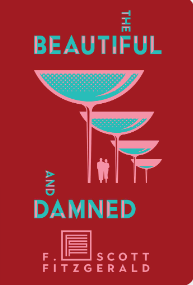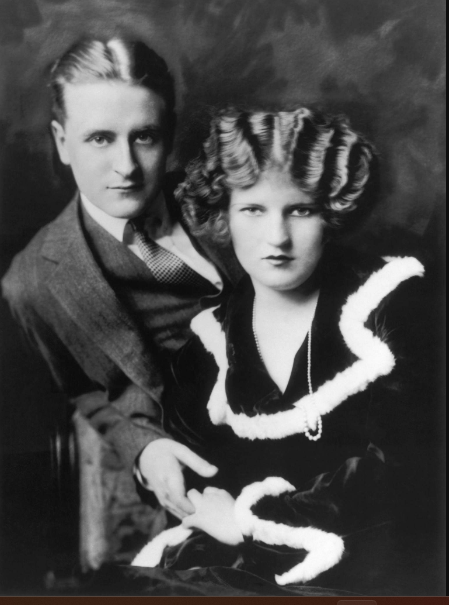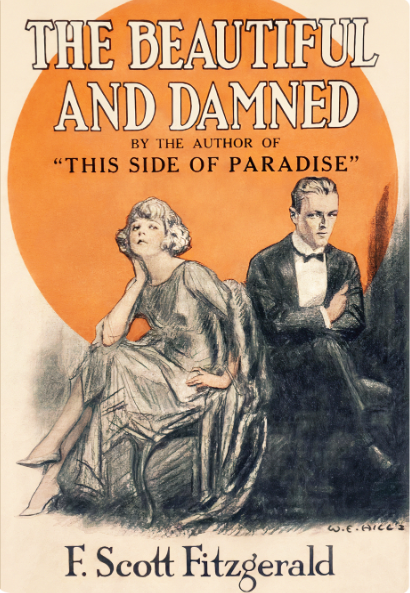The Beautiful and Damned by F. Scott Fitzgerald
My rating: 5 of 5 stars

For a book to have the title, and the cover pictured above, you can imagine what “damned” the beautiful people in the book. But to limit their “damnation” to just alcohol itself would be to oversimplify a very well-written and remarkably insightful novel.
Published in 1922, it was Fitzgerald’s second novel. He was only 25 years old.
Fitzgerald modeled the spoiled characters of Anthony Patch on himself and Gloria Patch on—in his words—the chill-minded selfishness of his wife.”
Fitzgerald, F. Scott (July 1966) [January 1940]. Turnbull, Andrew (ed.). The Letters of F. Scott Fitzgerald. New York: Charles Scribner’s Sons – via Internet Archive.
It was a novel of its tim a probing satire of its time- a probing satire of the Jazz Age, of which Fitzgerald was the self-appointed laureate, and a meditiation of the necissity for a calling or vocation in life.”
(Fitzgerald & W., 2020) p. VII

Portrait of Scott and Zelda by Alfred Cheney Johnston, 1923

The cover of the first edition, March 4, 1922, Charles Scribner’s and Sons
For Gloria and Anthony Patch, “Life, it seemed must be a setting up of props around one- otherwise, it was a disaster.” How to describe these characters?
“In 1913, when Anthony Patch was twenty-five, two years were already gone since irony, the Holy Ghost of this later day, had, theoretically at least, descended upon him.” Anthony cannot find something to do with himself, a vocation. He sometimes pretends to “write history” but he is just killing time until he inherits his grandfather’s fortune.
Gloria is beautiful, and “darn nice- not a brain in her head.” As she describes herself, she is “like Japanese lanterns and crepe paper and the music and orchestra…she has a streak of cheapness,” but the world is hers while she is young and beautiful.
Their exploits are a criticism of the Jazz Age lifestyle in NYC. Parties and drinking are the main pastimes for the couple and their friends.
In the introduction to the Modern Classics Kindle edition, Hortense Calisher writes that
As West writes, “Lack of vocation opens the door to a common problem for the wealthy: alcoholism.”
Liquor had become a practical necessity to their amusement”
(Fitzgerald & W., 2020), p. 271
The Beautiful and Damned is a revealing study of the corrosive effects of drinking on personality and character. Idle and without purpose, Anthony slips into a rhythm of imbibing that blunts his will and robs him of judgement.
(Fitzgerald & W., 2020) p. XIII
It is a slow downhill slide. Although Fitzgerald toyed with alternate endings, he decided to publish this book as a tragedy. Neither character learns anything or changes.
“I showed them,” he was saying. It was a hard fight, but I didn’t give up and I came through.”
(Fitzgerald & W., 2020) p. 435
The book is over 100 years old but still, a relevant and enjoyable exploration of the effects money, beauty, and purpose have on the human psyche. In my next installment, I will elaborate on the misadventures and hijinks found not only in this book but in the Fitzgerald Short Stories of this period.
“Fitzgerald does use works as a juggler might…simple- see through that net a certain iridescence as if they spin up and then home into place…There is not a dead sentence among them, not a moment when Fitzgerald’s magic fails to work.”
Hortense Calisher, Introduction, “The Beautiful and Damned”
August 15, 2009 by Modern Library
Sources:
Fitzgerald, F. Scott (July 1966) [January 1940]. Turnbull, Andrew (ed.). The Letters of F. Scott Fitzgerald. New York: Charles Scribner’s Sons – via Internet Archive. (ed.). The Letters of F. Scott Fitzgerald. New York: Charles Scribner’s Sons – via Internet Archive.
Fitzgerald, F. S., & W., W. J. L. (2020). The beautiful and damned. Scribner.
View all my reviews
